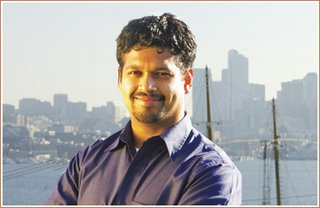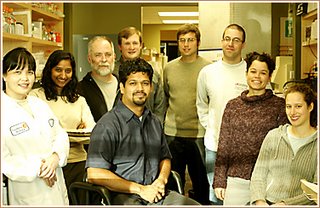

Dr. Nitin Baliga
Ph.D., Microbiology
University of Massachusetts at Amherst
M.Sc., Marine Biotechnology
Goa University, India
Dr. Baliga is particularly interested in crafting systems level approaches to understand how organisms mount responses to complexes changes in their environment. He holds an undergraduate degree in Microbiology from Ruia College, India and a M.Sc. In Marine Biotechnology from Goa University, India. Dr. Baliga conducted his doctoral studies in Microbiology at University of Massachusetts at Amherst and his postdoctoral studies in systems biology with Dr. Leroy Hood at ISB. During his predoctoral studies, he won two competitive awards from the government. Of India: the Council for Scientific and Industrial Research Fellowship, and a fellowship from the Department of Biotechnology.
Current research in Dr. Baliga's laboratory is geared towards elucidating complete sets of genetic circuits in Halobacterium NRC-1 that specify its robust behavior in an ever-changing hypersaline (saturated salt) environment. Dr. Baliga's research involves scientists of varied expertise in diverse areas such as environmental molecular microbiology, structural biology and computational biology.
Dr. Baliga has also made significant contributions to improving biology education in high schools throughout the greater Seattle area. His primary goal is to develop mind stimulating inquiry modules that teach high school students novel concepts in biology such as systems biology. Research in Dr. Baliga's laboratory is supported by research grants from the National Science Foundation, the Department of Defense, the NASA and Department of Energy.
Areas of Research
Baliga Laboratory Research
Overview: All organisms have a remarkable capacity to process complex changes and adjust behavior to best suit their environment. The cascade of events from sensing an environmental change and triggering a response constitute many layers of intricate information processing pathways such as signal transduction, pre- and post-transcriptional regulation, post-translation regulation, and allosteric modulation of enzyme function. Information is propagated in a controlled manner through all of these complex layers to effect a systemic change in cell behavior. Therefore, a systems approach is necessary to fully understand the how these complex processes operate.
In a systems approach, the various cellular networks are perturbed by changing environmental conditions or directly perturbing the network by removing genes or modifying their function. One can then measure consequences of these changes as they reverberate throughout the cellular networks. Some changes that can be measured using current technologies include mRNA levels, protein abundance, protein-protein interactions, protein-DNA interactions, protein modifications and metabolite concentrations. The ultimate goal is to process all these measurements to formulate mathematical models that recapitulate all previous observations and predict new behavior in face of novel environmental perturbations.
The Baliga laboratory is using simple prokaryotic model organisms such as Halobacterium NRC-1 to delineate the entire systems approach necessary for mathematically modeling cellular behavior at a mechanistic level. Their long term vision is to use predictive mathematical models for gene regulatory networks to engineer designer circuits for a variety of biotechnological applications such as environmental clean up. Because quality of the deciphered network depends on quality of measurements of inputs, outputs and intracellular changes that occur during an environmental response, the Baliga laboratory has adopted an array of cutting-edge tools and technologies. These tools and technologies span laboratory and computational approaches including cell culturing, measurement of interactions among proteins and between proteins and DNA, data management, integration, mathematical analysis, and visualization. For example, cell culturing is conducted in a controlled environment using an environmental chemostat or in a sun box which can deliver defined doses of radiation. Cell sorting strategies are used to isolate cells of similar characteristics such as size and DNA content. High density DNA arrays are used to measure mRNA levels and transcription factor binding sites (ChIP-chip). In collaboration with Dr. Carl Hansen's laboratory of the University of British Columbia, they are also developing microfluidics strategies for monitoring cell behavior in a controlled microenvironment.
Tools routinely used in the Baliga group include an in-frame chromosomal gene replacement strategy, protein expression systems for over-expression and epitope tagging of candidate proteins, a high density expression microarray for measuring mRNA level changes, a whole genome high density array for monitoring protein-DNA interactions using ChIP-chip, and ICAT- and iTRAQ-based proteomic technologies for measuring protein levels and protein-protein interactions. The Baliga laboratory also develops data management and visualization software to analyze complex systems biology datasets that result from these high-throughput inquiry strategies.
Ongoing projects in Dr. Baliga's group include:
- Study of cellular responses to extreme environmental factors
- Transcription Regulatory Networks
- Development of Gaggle and data standards schema Software solutions for systems biology data standardization, integration, and seamless exploration.
- Regulatory network inference.
For more information on Dr. Baliga's research visit http://halo.systemsbiology.net
Key collaborations within ISB:
Leroy Hood, Jeff Ranish, Ruedi Aebersold, Ger Van Den Engh, Carl Hansen
Key collaborations outside ISB:
Carl Johnson, Jocelyn DiRuggiero, Raafat El-Geweley
Awards received:
- Council for Scientific and Industrial Research (CSIR) Junior Research Fellowship for graduate research in India. Awarded by the Central Government of India. 1994-1996.
- Department of Biotechnology (DBT) scholarship for graduate study in Biotechnology. Awarded by the Central Government of India. 1992-1994.
- Diploma in Systems Management, National Institute for Information Technology, Bombay, India. 1991.

No comments:
Post a Comment